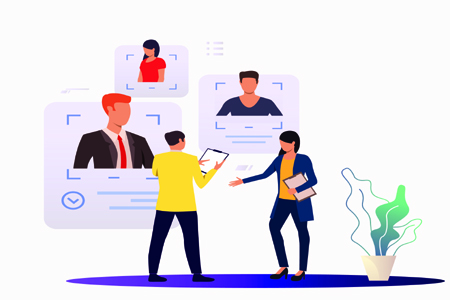
Software Development Lifecycle
The software development lifecycle (SDLC) is the cost-effective and time-efficient process that development teams use to design and build high-quality software. The goal of SDLC is to minimize project risks through forward planning so that software meets expectations during production and beyond.
VBJ SDLC phases:
Plan - The plan phase typically includes tasks like cost-benefit analysis, scheduling, resource estimation, and allocation. The development team collects requirements from several stakeholders such as customers, internal and external experts, and managers to create a software requirement specification document.
Design - In the design phase, software engineers analyze requirements and identify the best solutions to create the software. They will look at how to best integrate the new software into any existing IT infrastructure the organization may have.
Implement - In the implementation phase, the development team codes the product. They analyze the requirements to identify smaller coding tasks they can do daily to achieve the final result.
Test - The development team combines automation and manual testing to check the software for bugs. Quality analysis includes testing the software for errors and checking if it meets as per requirements.
Deploy - Develop software code and test on a different copy of the software than the one that the users have access to called production, while other copies are said to be in the build environment, or testing environment.
Maintain- In the maintenance phase, among other tasks, the team fixes bugs, resolves customer issues, and manages software changes. In addition, the team monitors overall system performance, security, and user experience to identify new ways to improve the existing software.

JAVA Applications:
VBJ Develop applications on JAVA technology platforms on Windows, Mac, Linux, Raspberry Pi, etc. Java has gained the most popular programming language in the world, easy to learn and simple to use, open-source and free, secure, fast and powerful, Java is an object oriented language which gives a clear structure to programs and allows code to be reused, lowering development costs. Java is a class-based, object-oriented programming language that is designed to have as few implementation dependencies as possible. It is intended to let application developers write once, and run anywhere, meaning that compiled Java code can run on all platforms that support Java without the need for recompilation. Java widely used for developing applications for desktop, web, and mobile devices. Java is known for its simplicity, robustness, and security features, making it a popular choice for enterprise-level applications.
Desktop Applications:
VBJ develop Desktop Applications keep in mind that Users don’t need an internet connection to access, considered safer options since all the user data is stored on a physical machines , Processes are typically executed faster on desktop apps Our Desktop application is a dedicated software program designed to run on a standalone computer, enabling end-users to execute specific tasks. Applications cater to a diverse range of functions users have the flexibility to augment their desktop functionality by downloading and installing various applications directly from the Internet or purchasing them from software vendors. Desktop applications are tailored to operate on specific operating systems, such as Windows, Mac, or Linux. This specialization ensures optimal performance and compatibility within the chosen environment. End-users are responsible for installing updates to desktop applications. Desktop applications are designed to function in an isolated environment. When subjected to penetration testing services, these applications have demonstrated a reduced susceptibility to security issues. This isolation contributes to a more controlled and secure user experience.
Mobile Applications:
VBJ develop mobile application specifically for use on small, wireless computing devices, such as smartphones and tablets, rather than desktop or laptop computers. Our Mobile applications frequently serve to provide users with similar services to those accessed on PCs. Apps are generally small, individual software units with limited function. Our Mobile apps are categorized according to whether they are web-based or native apps, which are created specifically for a given platform. A third category, hybrid apps, combines elements of both native and web apps. It provide a wide range of functions and services and with consideration for the demands, constraints and capabilities of the devices they're built for. Our develop Mobile apps can be downloaded and installed on a device, allowing users to access the app's functions and services at any time, from anywhere, customized to meet the specific needs of individual users, providing a personalized experience, use offline, providing access to important information and features even when an internet connection is not available, push notifications to users, providing real-time updates on important information and events.

.NET Applications:
VBJ .NET Framework is part of the .NET platform, a collection of technologies for building applications but not limited to websites, services, desktop apps, and more on Windows. .NET Standard is a formal specification of the APIs that are common across .NET implementations. This allows the same code and libraries to run on different implementations. VBJ works on .Net Common Language Runtime (CLR) is the execution engine that handles running applications. It provides services like thread management, garbage collection, type-safety, exception handling, and more. The Class Library provides a set of APIs and types for common functionality. It provides types for strings, dates, numbers, etc. The Class Library includes APIs for reading and writing files, connecting to databases, drawing, and more.
DevOps:
VBJ DevOps use as a set of practices and tools, DevOps integrates and automates the work of software development (Dev) and IT operations (Ops) as a means for improving and shortening the systems development life cycle. It a combination of cultural philosophies, practices, and tools that increases an organization's ability to deliver applications and services. Our DevOps team includes developers and IT operations working collaboratively throughout the product lifecycle, in order to increase the speed and quality of software deployment.
Benefits of DevOps:
Speed - Move at high velocity by that innovate for customers faster, adapt to changing markets better, and grow more efficient at driving business results.
Rapid Delivery - Increase the frequency and pace of releases so that more be can innovate and improve product faster. The quicker product would be release new features and fix bugs, the faster can respond to customers needs and build competitive advantage.
Reliability - Ensure the quality of application updates and infrastructure changes so that reliably deliver at a more rapid pace while maintaining a positive experience for end users. Use practices like continuous integration and continuous delivery to test that each change is functional and safe.
Improved Collaboration - Build more effective teams under a DevOps cultural model, which emphasizes values such as ownership and accountability. Developers and operations teams collaborate closely, share many responsibilities, and combine their workflows. This reduces inefficiencies and saves time reduced handover periods between developers and operations, writing code that takes into account the environment in which it is run.
Fullstack Development:
Full stack development refers to the end-to-end application software development, including the front end and back end. The front end consists of the user interface, and the back end takes care of the business logic and application workflows. Responsible for coding end-to-end workflows by using both front-end and back-end technologies. VBJ Full Stack takes complete ownership and understanding of the project , Saves both project time and cost, and enhances productivity , Faster bug fixing due to knowledge of complete system , Easy knowledge transfer to other team members and Better division of work amongst team members. Our Full stack development provides a faster and more efficient development experience to build applications, equipped with the knowledge of various technologies and tools. Our Full stack development is the process of designing, creating, testing, and deploying a complete web application from start to finish. It involves working with various technologies and tools, including front-end web development, back-end web development, and database development.

ServiceNow:
VBJ ServiceNow is a cloud-based workflow automation platform that enables enterprise to improve operational efficiencies by streamlining and automating routine work tasks. It has been evolve to become the enterprise service management platform for organizations, uniting all business functions from customer service to human resources and to security, and more. ServiceNow is one of those rare software platforms that can show a rapid return on investment, and continue to deliver strong value as the organization expands its use. The ServiceNow platform easily integrates with other tools, letting users manage projects, teams and customer interactions using a variety of apps and plugins. The service model of ServiceNow products is based on helping users identify the root cause of issues they encounter and correct these issues via self-service, tasks, activities and processes from ServiceNow products, separated by cloud service. ServiceNow's cloud services include a suite of products that enable users and companies to operate using serverless computing. ServiceNow offers a wide range of tools that integrate smoothly with many legacy systems, the company's products can support most workflows. Common uses for ServiceNow products include ticketing systems to manage large projects, benchmarking to track progress and predictive modeling to manage workflows. ServiceNow business model is based on providing cloud-based software as a service, or SaaS. This model involves setting up systems to define, manage, automate and structure services.
Data Engineering:
It is the practice of design and build systems for collecting, storing, and analysing data at scale. This is the process of design and build systems that let people collect and analyze raw data from multiple sources and formats. These systems empower people to find practical applications of the data, which businesses can use to thrive. VBJ Data engineering is design to support the process, making it possible for consumers of data, such as analysts, data scientists and executives, to reliably, quickly and securely inspect all of the data available.
Software Testing:
Software Testing is a method to assess the functionality of the software program. The process checks whether the actual software matches the expected requirements and ensures the software is bug-free.
VBJ is an expert level of software testing:
Acceptance testing: Verifying whether the whole system works as intended.
Code Review:Are an effective means to confirm that new and modified software is following an organization’s coding standards and adheres to its best practices.
Integration Testing: Ensuring that software components or functions operate together.
Unit Testing: Validating that each software unit performs as expected. A unit is the smallest testable component of an application.
Functional Testing:Checking functions by emulating business scenarios, based on functional requirements. Black-box testing is a common way to verify functions.
Performance Testing: Testing how the software performs under different workloads. Load testing, for example, is used to evaluate performance under real-life load conditions.
Regression Testing:Checking whether new features break or degrade functionality. Sanity testing can be used to verify menus, functions and commands at the surface level, when there is no time for a full regression test.
Security Testing: validate that your software is not open to hacker or other malicious types of vulnerabilities that could be exploited to deny access to your services or cause them to perform incorrectly.
Stress testing: Testing how much strain the system can take before it fails. Considered to be a type of non-functional testing.
Usability testing: Validating how well a customer can use a system or web application to complete a task.



